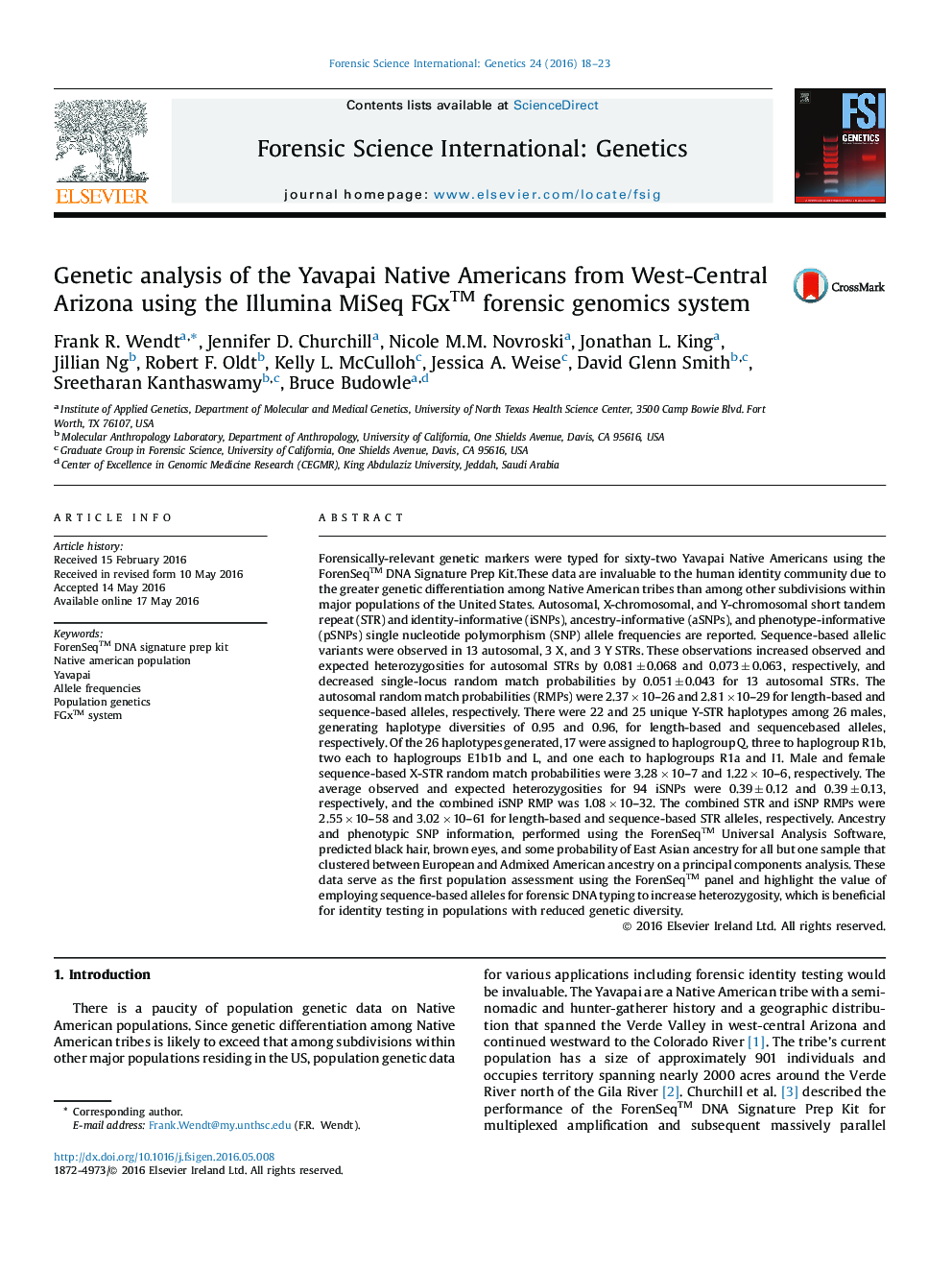| کد مقاله | کد نشریه | سال انتشار | مقاله انگلیسی | نسخه تمام متن |
|---|---|---|---|---|
| 6553508 | 160871 | 2016 | 6 صفحه PDF | دانلود رایگان |
عنوان انگلیسی مقاله ISI
Genetic analysis of the Yavapai Native Americans from West-Central Arizona using the Illumina MiSeq FGx⢠forensic genomics system
دانلود مقاله + سفارش ترجمه
دانلود مقاله ISI انگلیسی
رایگان برای ایرانیان
موضوعات مرتبط
علوم زیستی و بیوفناوری
بیوشیمی، ژنتیک و زیست شناسی مولکولی
ژنتیک
پیش نمایش صفحه اول مقاله

چکیده انگلیسی
Forensically-relevant genetic markers were typed for sixty-two Yavapai Native Americans using the ForenSeq⢠DNA Signature Prep Kit.These data are invaluable to the human identity community due to the greater genetic differentiation among Native American tribes than among other subdivisions within major populations of the United States. Autosomal, X-chromosomal, and Y-chromosomal short tandem repeat (STR) and identity-informative (iSNPs), ancestry-informative (aSNPs), and phenotype-informative (pSNPs) single nucleotide polymorphism (SNP) allele frequencies are reported. Sequence-based allelic variants were observed in 13 autosomal, 3 X, and 3 Y STRs. These observations increased observed and expected heterozygosities for autosomal STRs by 0.081 ± 0.068 and 0.073 ± 0.063, respectively, and decreased single-locus random match probabilities by 0.051 ± 0.043 for 13 autosomal STRs. The autosomal random match probabilities (RMPs) were 2.37 Ã 10-26 and 2.81 Ã 10-29 for length-based and sequence-based alleles, respectively. There were 22 and 25 unique Y-STR haplotypes among 26 males, generating haplotype diversities of 0.95 and 0.96, for length-based and sequencebased alleles, respectively. Of the 26 haplotypes generated, 17 were assigned to haplogroup Q, three to haplogroup R1b, two each to haplogroups E1b1b and L, and one each to haplogroups R1a and I1. Male and female sequence-based X-STR random match probabilities were 3.28 Ã 10-7 and 1.22 Ã 10-6, respectively. The average observed and expected heterozygosities for 94 iSNPs were 0.39 ± 0.12 and 0.39 ± 0.13, respectively, and the combined iSNP RMP was 1.08 Ã 10-32. The combined STR and iSNP RMPs were 2.55 Ã 10-58 and 3.02 Ã 10-61 for length-based and sequence-based STR alleles, respectively. Ancestry and phenotypic SNP information, performed using the ForenSeq⢠Universal Analysis Software, predicted black hair, brown eyes, and some probability of East Asian ancestry for all but one sample that clustered between European and Admixed American ancestry on a principal components analysis. These data serve as the first population assessment using the ForenSeq⢠panel and highlight the value of employing sequence-based alleles for forensic DNA typing to increase heterozygosity, which is beneficial for identity testing in populations with reduced genetic diversity.
ناشر
Database: Elsevier - ScienceDirect (ساینس دایرکت)
Journal: Forensic Science International: Genetics - Volume 24, September 2016, Pages 18-23
Journal: Forensic Science International: Genetics - Volume 24, September 2016, Pages 18-23
نویسندگان
Frank R. Wendt, Jennifer D. Churchill, Nicole M.M. Novroski, Jonathan L. King, Jillian Ng, Robert F. Oldt, Kelly L. McCulloh, Jessica A. Weise, David Glenn Smith, Sreetharan Kanthaswamy, Bruce Budowle,